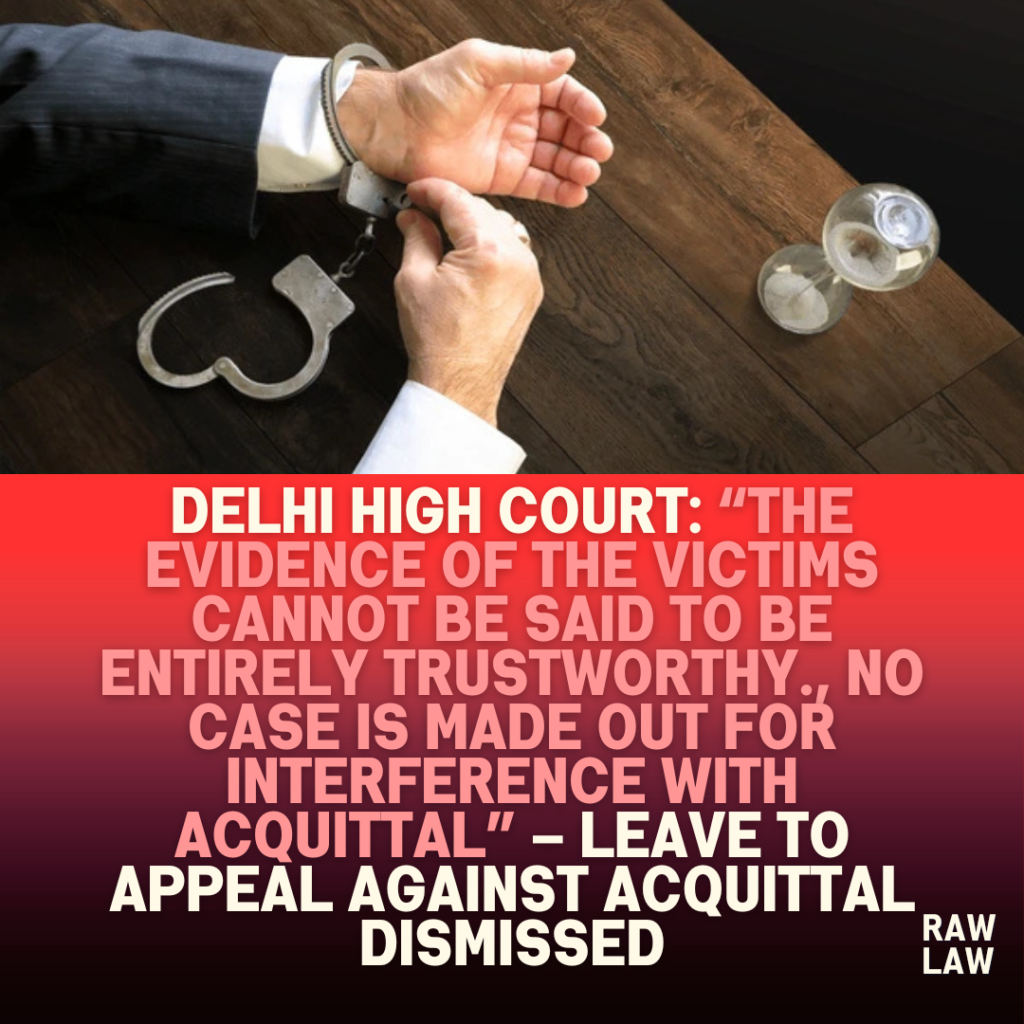Court’s Decision
The Delhi High Court dismissed the State’s petition seeking leave to appeal against the acquittal of the accused under Sections 323/324/34 IPC. Justice Amit Mahajan held that:
“In the absence of any independent corroboration, considering the multiple discrepancies in the case of the prosecution, the evidence of the victims cannot be said to be entirely trustworthy.”
The Court declined to condone the inordinate delay of 681 days in filing the petition, holding that no sufficient cause had been shown. It emphasized that even on merits, there were no substantial or compelling grounds warranting interference with the acquittal.
Facts
The case arose from an incident on 7 March 2012, wherein the accused allegedly assaulted the complainant and her family members using bricks and a sharp object. The complainant alleged that the accused, who were her neighbours, arrived intoxicated and assaulted her. Her brother, his friend, and her mother were also allegedly injured during the altercation.
A chargesheet was filed under Sections 323/324/34 IPC. The prosecution examined 10 witnesses, including the complainant and other injured individuals. However, the Trial Court acquitted the accused on 28 September 2019, citing contradictions in testimonies and lack of corroboration by independent witnesses.
Issues
- Whether the prosecution had made out a prima facie case to warrant interference with the acquittal?
- Whether the delay of 681 days in filing the petition could be condoned in the interest of justice?
Petitioner’s Arguments
The Additional Public Prosecutor submitted that:
- The Trial Court failed to appreciate the evidentiary value of the injured witnesses’ testimonies.
- Minor contradictions were wrongly given undue weight.
- PW1 to PW4, who were both victims and eyewitnesses, clearly identified the accused and narrated the assault.
- The delay in filing the petition was due to administrative movement of the file and the COVID-19 pandemic, and ought to be condoned.
Respondent’s Arguments
The defence counsel argued that:
- The delay was excessive and unexplained; no case was made for condonation.
- The Trial Court rightly acquitted the accused after carefully assessing material contradictions in witness depositions.
- No sharp-edged weapon was recovered from the accused.
- The prosecution failed to examine a single independent witness despite the alleged incident occurring in a densely populated area.
Analysis of the Law
The Court noted that under Section 378(3) CrPC, the State must first seek leave to appeal an acquittal. Referring to the Supreme Court’s decision in Maharashtra v. Sujay Mangesh Poyarekar (2008) 9 SCC 475, the Court reiterated that:
“In deciding the question whether requisite leave should or should not be granted, the High Court must apply its mind, consider whether a prima facie case has been made out or arguable points have been raised.”
It further clarified that courts should not interfere with acquittals unless compelling reasons are demonstrated.
Precedent Analysis
- Maharashtra v. Sujay Mangesh Poyarekar – The Supreme Court held that leave to appeal must be granted only upon prima facie satisfaction, and not merely because a different conclusion may be possible.
- Balu Sudam Khalde v. State of Maharashtra (2023) 13 SCC 365 – While emphasising that evidence of injured witnesses carries weight, the Supreme Court acknowledged that such evidence must be free from exaggeration and inconsistencies.
These judgments guided the High Court’s view that the Trial Court’s appreciation of contradictions was not perverse, but justified.
Court’s Reasoning
The Court meticulously analysed the inconsistencies and contradictions highlighted by the Trial Court, such as:
- Discrepancies about where and when the victim’s statements were recorded.
- Contradictory testimonies regarding who witnessed what and when.
- Inconsistencies about the alleged injuries to persons other than the complainant.
- Absence of any independent eyewitness from the neighbourhood.
- No recovery of the alleged sharp-edged weapon.
The Court observed:
“There are evident substantial embellishments in the case of the prosecution. In the absence of any independent corroboration… reasonable doubt has been created in favour of the accused persons.”
The Court also took note of the unnatural omission in the prosecution story — there was no reference to whether the accused themselves sustained any injuries, which would be expected in a mutual scuffle.
Conclusion
The Delhi High Court concluded that:
- The prosecution failed to explain the inordinate delay in filing the petition.
- No prima facie case or arguable point had been raised to justify leave to appeal.
- The Trial Court’s acquittal was based on a well-reasoned appreciation of evidence and contradictions.
Hence, the petition for leave to appeal and application for condonation of delay were dismissed.
Implications
This judgment reinforces the principle that appellate courts should exercise restraint in interfering with acquittals, especially when the trial court has carefully analysed the evidence. It affirms that:
- Injured witness testimony, while valuable, must be consistent and corroborated.
- Delay in challenging acquittals must be convincingly explained.
- Independent corroboration is essential in cases involving allegations of group assault in public settings.
Also Read: Bombay High Court Sets Aside Order Denying EMI Deduction in Sugar Revenue Share for 2016–2017



